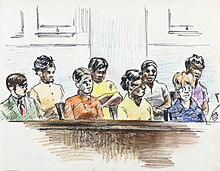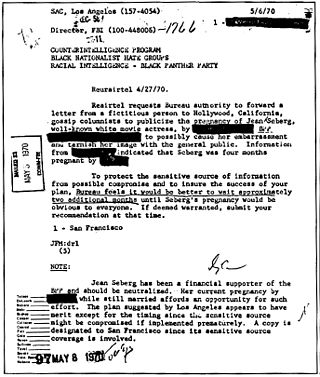
COINTELPRO was a series of covert and illegal projects conducted between 1956 and 1971 by the United States Federal Bureau of Investigation (FBI) aimed at surveilling, infiltrating, discrediting, and disrupting American political organizations that the FBI perceived as subversive. Groups and individuals targeted by the FBI included feminist organizations, the Communist Party USA, anti–Vietnam War organizers, activists in the civil rights and Black power movements, environmentalist and animal rights organizations, the American Indian Movement (AIM), Chicano and Mexican-American groups like the Brown Berets and the United Farm Workers, independence movements, a variety of organizations that were part of the broader New Left, and white supremacist groups such as the Ku Klux Klan and the National States' Rights Party.

Robert George Seale is an American political activist and author. Seale is widely known for co-founding the Black Panther Party with fellow activist Huey P. Newton. Founded as the "Black Panther Party for Self-Defense", the Party's main practice was monitoring police activities and challenging police brutality in Black communities, first in Oakland, California, and later in cities throughout the United States.
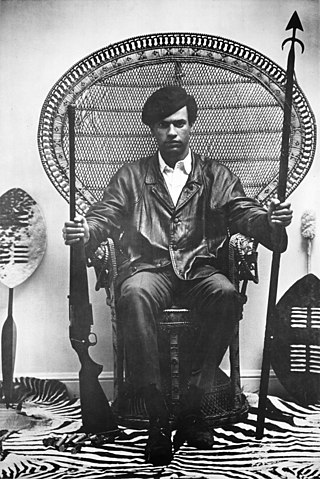
Huey Percy Newton was an African American revolutionary and political activist who founded the Black Panther Party. He ran the party as its first leader and crafted its ten-point manifesto with Bobby Seale in 1966.
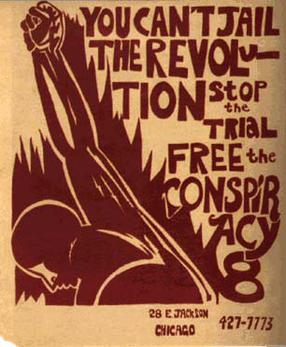
The Chicago Seven, originally the Chicago Eight and also known as the Conspiracy Eight or Conspiracy Seven, were seven defendants – Rennie Davis, David Dellinger, John Froines, Tom Hayden, Abbie Hoffman, Jerry Rubin, and Lee Weiner – charged by the United States Department of Justice with conspiracy, crossing state lines with intent to incite a riot, and other charges related to anti-Vietnam War and 1960s counterculture protests in Chicago, Illinois during the 1968 Democratic National Convention. The Chicago Eight became the Chicago Seven after the case against codefendant Bobby Seale was declared a mistrial.

Fredrick "Chairman Fred" Allen Hampton Sr. was an American activist. He came to prominence in his late teens and very early 20s in Chicago as deputy chairman of the national Black Panther Party and chair of the Illinois chapter. As a progressive African American, he founded the anti-racist, anti-classist Rainbow Coalition, a prominent multicultural political organization that initially included the Black Panthers, Young Patriots, and the Young Lords, and an alliance among major Chicago street gangs to help them end infighting and work for social change. A Marxist–Leninist-Maoist, Hampton considered fascism the greatest threat, saying, "nothing is more important than stopping fascism, because fascism will stop us all."

Elmer "Geronimo" Pratt, also known as Geronimo Ji-Jaga and Geronimo Ji-Jaga Pratt, was a decorated military veteran and a high-ranking member of the Black Panther Party in the United States in the late 1960s and early 1970s. Born in Louisiana, he served two tours in Vietnam, receiving several decorations. He moved to Los Angeles, where he studied at UCLA under the GI Bill and joined the Black Panther Party.
John Radford Froines was an American chemist and anti-war activist, noted as a member of the Chicago Seven, a group charged with involvement with the riots at the 1968 Democratic National Convention in Chicago. Froines, who held a Ph.D. in chemistry from Yale, was charged with interstate travel for purposes of inciting a riot and with making incendiary devices, but was acquitted. He later served as the Director of Toxic Substances at the federal Occupational Safety and Health Administration and then director of UCLA’s Occupational Health Center. He also served as chair of the California Scientific Review Panel on Toxic Air Contaminants for nearly 30 years before resigning in 2013 amid controversy and claims of conflict of interest.

Mark Clark was an American activist and member of the Black Panther Party (BPP). He was killed on December 4, 1969, with Fred Hampton, state chairman of the Black Panthers, during a Chicago police predawn raid.

John Jerome Huggins Jr. was an American activist. He was the leader in the Los Angeles chapter of the Black Panther Party who was killed by black nationalist US Organization members at the University of California, Los Angeles (UCLA) campus in January 1969. As part of COINTELPRO, the FBI sent forged letters to Black Nationalists to inflame tensions between the Panthers and US organisation. Lary 'Watani' Stiner and his brother, were accused and charged for Huggins' assassination.
Alex Rackley was an American activist who was a member of the New York chapter of the Black Panther Party (BPP) in the late-1960s. In May 1969, Rackley was suspected by other Panthers of being a police informant. He was brought to Panther headquarters in New Haven, Connecticut, held captive and tortured there for several days, condemned to death, taken to the wetlands of Middlefield, Connecticut, and murdered there.

George W. Sams Jr. was a member of the Black Panther Party convicted in the 1969 murder of New York Panther Alex Rackley, which resulted in the New Haven Black Panther trials of 1970.

Warren Aloysious Kimbro was a Black Panther Party member in New Haven, Connecticut who was found guilty of the May 21, 1969, murder of New York City Panther Alex Rackley, in the first of the New Haven Black Panther trials in 1970.
Lonnie McLucas was a Black Panther Party member in Bridgeport, Connecticut who was found guilty of conspiracy to commit murder for his involvement in the May 21, 1969 murder of New York City Panther Alex Rackley, in the first of the New Haven Black Panther trials in 1970.

The Black Panther Party was a Marxist–Leninist and black power political organization founded by college students Bobby Seale and Huey P. Newton in October 1966 in Oakland, California. The party was active in the United States between 1966 and 1982, with chapters in many major American cities, including San Francisco, New York City, Chicago, Los Angeles, Seattle, and Philadelphia. They were also active in many prisons and had international chapters in the United Kingdom and Algeria. Upon its inception, the party's core practice was its open carry patrols ("copwatching") designed to challenge the excessive force and misconduct of the Oakland Police Department. From 1969 onward, the party created social programs, including the Free Breakfast for Children Programs, education programs, and community health clinics. The Black Panther Party advocated for class struggle, claiming to represent the proletarian vanguard.
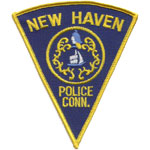
The New Haven Police Department is the law enforcement agency responsible for the city of New Haven, Connecticut.
Catherine Gertrude Roraback was a civil rights attorney in Connecticut, best known for representing Estelle Griswold and Dr. C. Lee Buxton in the famous 1965 Supreme Court case, Griswold v. Connecticut, which legalized the use of birth control in Connecticut and created the precedent of the right to privacy. She is also known for such cases as the New Haven Black Panther trials of 1971, in which she defended Black Panther member Ericka Huggins after she was accused of murder. Roraback dealt with issues such as women's rights and racial discrimination, and lived her life to defend the rights of the "dissenters and the dispossessed".

Ericka Huggins is an American activist, writer, and educator. She is a former leading member of the political organization, Black Panther Party (BPP). She was married to fellow BPP member John Huggins in 1968.

Seize The Time: The Story of The Black Panther Party and Huey P. Newton is a 1970 book by political activist Bobby Seale. It was recorded in San Francisco County Jail between November 1969 and March 1970, by Arthur Goldberg, a reporter for the San Francisco Bay Guardian. An advocacy book on the cause and principles of the Black Panther Party, Seize The Time is considered a staple in Black Power literature.
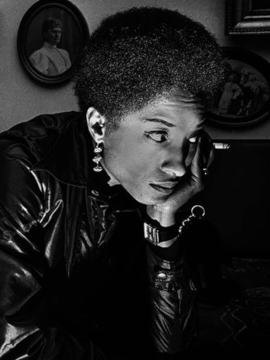
Constance Evadine Matthews, better known as Connie Matthews, was an organizer, a part of the Black Panther Party between 1968 and 1971. A resident of Denmark, she helped co-ordinate the Black Panthers with left-wing political groups based in Europe.

